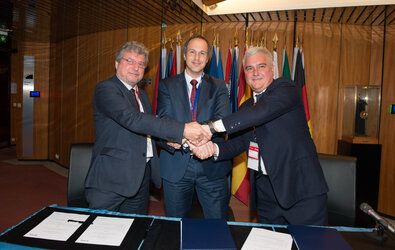Accept all cookies Accept only essential cookies See our Cookie Notice

About ESA
The European Space Agency (ESA) is Europe’s gateway to space. Its mission is to shape the development of Europe’s space capability and ensure that investment in space continues to deliver benefits to the citizens of Europe and the world.
Highlights
ESA - United space in Europe
This is ESA ESA facts Member States & Cooperating States Funding Director General Top management For Member State Delegations European vision European Space Policy ESA & EU Space Councils Responsibility & Sustainability Annual Report Calendar of meetings Corporate newsEstablishments & sites
ESA Headquarters ESA ESTEC ESA ESOC ESA ESRIN ESA EAC ESA ESAC Europe's Spaceport ESA ESEC ESA ECSAT Brussels Office Washington OfficeWorking with ESA
Business with ESA ESA Commercialisation Gateway Law at ESA Careers Cyber resilience at ESA IT at ESA Newsroom Partnerships Merchandising Licence Education Open Space Innovation Platform Integrity and Reporting Administrative Tribunal Health and SafetyMore about ESA
History ESA Historical Archives Exhibitions Publications Art & Culture ESA Merchandise Kids Diversity ESA Brand Centre ESA ChampionsLatest
Space in Member States
Find out more about space activities in our 23 Member States, and understand how ESA works together with their national agencies, institutions and organisations.
Science & Exploration
Exploring our Solar System and unlocking the secrets of the Universe
Go to topicAstronauts
Missions
Juice Euclid Webb Solar Orbiter BepiColombo Gaia ExoMars Cheops Exoplanet missions More missionsActivities
International Space Station Orion service module Gateway Concordia Caves & Pangaea BenefitsLatest
Space Safety
Protecting life and infrastructure on Earth and in orbit
Go to topicAsteroids
Asteroids and Planetary Defence Asteroid danger explained Flyeye telescope: asteroid detection Hera mission: asteroid deflection Near-Earth Object Coordination CentreSpace junk
About space debris Space debris by the numbers Space Environment Report In space refuelling, refurbishing and removingSafety from space
Clean Space ecodesign Zero Debris Technologies Space for Earth Supporting Sustainable DevelopmentLatest
Applications
Using space to benefit citizens and meet future challenges on Earth
Go to topicObserving the Earth
Observing the Earth Future EO Copernicus Meteorology Space for our climate Satellite missionsCommercialisation
ESA Commercialisation Gateway Open Space Innovation Platform Business Incubation ESA Space SolutionsLatest
Enabling & Support
Making space accessible and developing the technologies for the future
Go to topicBuilding missions
Space Engineering and Technology Test centre Laboratories Concurrent Design Facility Preparing for the future Shaping the Future Discovery and Preparation Advanced Concepts TeamSpace transportation
Space Transportation Ariane Vega Space Rider Future space transportation Boost! Europe's Spaceport Launches from Europe's Spaceport from 2012Latest

Space Rider's ALEK in LEAF on Vega third stage
Thank you for liking
You have already liked this page, you can only like it once!
A part of the orbital module for the European Space Agency’s reuseable spacecraft Space Rider in the LEAF facility at the Agency’s technical heart in The Netherlands, 28 March 2025.
Space Rider is a versatile reuseable spacecraft about the size of two minivans that allows for all kind of missions, from pharmaceutical research to visiting orbital platforms and more. After missions that can last up to three months, Space Rider returns to Earth, and precision-lands on skids after a paraglider descent.
While in orbit Space Rider relies on a Vega-C rocket fourth stage called AVUM+ (Attitude Vernier Upper Module) with a new element built by Beyond Gravity for Avio, called ALEK (AVUM Life Extension Kit). The rocket fourth stage provides propulsion to move and orient the spacecraft and the ALEK provides electricity and other services needed for the orbital life of the vehicle with two solar panel wings. Together these elements make up the expendable orbital module that separates from the Space Rider reentry module before its return to Earth.
ALEK’s structure spent two months at ESA’s testing facility being put through the full range of mechanical tests and stresses it will experience when launched on a Vega-C rocket.
ALEK's last test was a shock test, checking the service module would hold it together when it separates from the Vega-C rocket that propels it to orbit. For this test, Alek was placed on top of a model of the fourth stage of Vega-C, equipped to simulate some the shocks that are generated by the rocket on ascent, verifying how the shocks are transferred through the structure. The shock test was performed in the same acoustic chamber, LEAF.
The largest European facility of its kind, ESA's Large European Acoustic Facility (LEAF) is a test chamber measuring 11 m wide by 9 m deep and 16.4 m high. Its walls are made of steel-reinforced concrete 0.5 m thick to contain the sound and are coated with a thick coating of epoxy resin to reduce noise absorption and increase internal reverberation.
One wall is fitted with noise horns of the same basic design as those seen in stereo speakers which can produce noise equivalent to multiple jet aircraft lifting off simultaneously from 30 metres away.
-
CREDIT
Avio -
LICENCE
ESA Standard Licence

Space Rider's ALEK in LEAF

Space Rider's ALEK in accoustic chamber

Space Rider's ALEK on shaker

Inspecting Space Rider's ALEK















 Germany
Germany
 Austria
Austria
 Belgium
Belgium
 Denmark
Denmark
 Spain
Spain
 Estonia
Estonia
 Finland
Finland
 France
France
 Greece
Greece
 Hungary
Hungary
 Ireland
Ireland
 Italy
Italy
 Luxembourg
Luxembourg
 Norway
Norway
 The Netherlands
The Netherlands
 Poland
Poland
 Portugal
Portugal
 Czechia
Czechia
 Romania
Romania
 United Kingdom
United Kingdom
 Slovenia
Slovenia
 Sweden
Sweden
 Switzerland
Switzerland
























